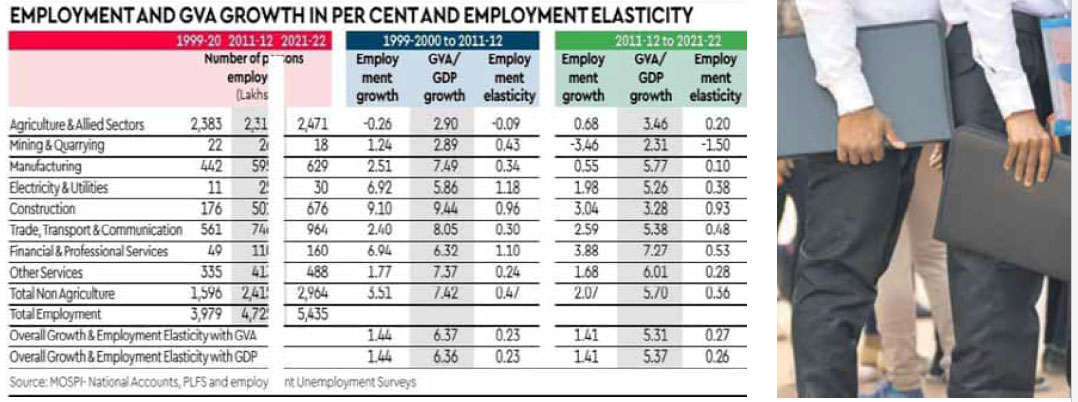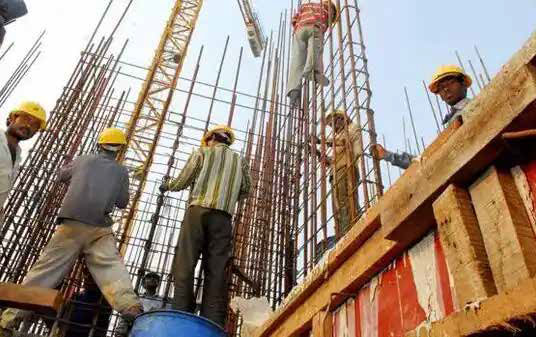It is necessary to pursue employment as an independent objective and not have it as an outcome of growth. More than ten million people entering the employment market every year cannot otherwise find jobs.
From 1972-73 to 1993-94, for every 1% of GDP growth, employment grew by 0.48%. During 1993-94 to 1999-2000, GDP grew 6.8% and employment grew by 1% annually. The period between 2004-05 to 2009-10 showed jobless growth with annual GDP growing at 8.7% and employment growing at 0.1% annually. During 2011-12 to 2021-22 (the latest period for which the employment data is available), average GDP growth was at 5.4%, with an average employment growth of 1.4%. We had demonetisation in 2016, introduction of the GST in 2017, and the pandemic in 2019-20. The changes up to the pandemic moderated both growth in income and jobs. Post the pandemic, with expansionary fiscal and monetary measures, there is a return to normalcy with growth averaging 7.5% in the last 10 quarters and employment showing signs of revival.
The Periodic Labour Force Survey (PLFS) was introduced in 2017-18. Prior to that, employment data gathering was a five yearly exercise. The last such data is from 2011-12. The Labour Bureau came out with an annual survey during 2011-12 to 2016-17, but there were issues of consistency and comparability, including the NSSO quality guarantee. The PLFS 2017-18 indicated that overall employment has declined from 472 million in 2011-12 to 457 million in 2017-18. There was a decline of 25 million in the female workforce during this period. Job creation post 2017-18 improved, and in the four years since then, 86 million incremental jobs were created, while an additional 80 million were seeking jobs.
The accompanying graphic provides overall employment, compound average annual employment growth, growth of gross value added in the sectors and employment elasticity for two periods (period I being 1999-2000 to 2011-12, and period II being 2011-12 to 2021-22).
The elasticity of employment was negative in agriculture in period I and positive in period II. Agriculture can’t retain a large labour force. Adoption of sustainable technologies, freeing internal and external trade in agri-commodities, with government intervention only at critical times, and transfer of manpower to secondary and tertiary sectors through labour intensive manufacturing and higher growth in services are critical for a sustained growth of persons engaged in agriculture. Post pandemic, reverse migration has contributed to the positive employment elasticity in agriculture.
The performance of manufacturing in period II was dismal. Notwithstanding available manufacturing centric policies, employment elasticity was just 0.1. This sector employs only 62 million people. Perhaps, manufacturing strategy needs a paradigm shift, and we are yet to understand the core issues that will enable manufacturing to reach 25% of GVA. Manufacturing has been helped by a booming construction sector, including real estate and public infrastructure.

Spread of labour-intensive manufacturing in areas where labour is available by implementing policies favorable to positioning such industries will require sustained effort by both the Centre and the states. A collateral benefit in doing so will be increased consumption and exports of labour-intensive products in the country.
Construction has indeed been a sunrise sector. This relatively low-technology and labour-intensive sector had an employment growth of 9% in period I and 3% in period II, with a near unity in employment elasticity. This underscores the importance of MGNREGA and infrastructure development and perhaps an easy shift of labour from agriculture.
 Trade, hotels, transport, and communication services has been the second-largest sector in absorbing labour. These entities are mostly in the household sector. They face challenges from organised retail, digital, and home deliveries. Increased digitisation and incorporation into the e-commerce ecosystem will help them. Enhanced technology usage in transport and communication along with reducing costs in regulation will further help them. Focus on skill development is bound to enhance employment. Financial and professional services will continue to perform well because of increased need for intermediation and consultancy. But these are upscale market jobs and not the point of first jump from unorganised to skilled.
Trade, hotels, transport, and communication services has been the second-largest sector in absorbing labour. These entities are mostly in the household sector. They face challenges from organised retail, digital, and home deliveries. Increased digitisation and incorporation into the e-commerce ecosystem will help them. Enhanced technology usage in transport and communication along with reducing costs in regulation will further help them. Focus on skill development is bound to enhance employment. Financial and professional services will continue to perform well because of increased need for intermediation and consultancy. But these are upscale market jobs and not the point of first jump from unorganised to skilled.
Other services are a heterogeneous mix of public administration and defence, education, health, art and recreation, and other services. Public administration and defence account for nearly 20% of these services. With faceless delivery of public services, growth of employment in public administration is unlikely. Skill development, use of appropriate technology, and regulation and quality upgradation in health and education will make them more accessible and affordable.
Policies to increase female labour force participation ratio from the current 24% will help. This was 33% in 1993-94. To increase female participation, we need cultural acceptance, emphasis on female education, creation of auxiliary facilities for working women, and their skill upgradation. But an increase in labour force participation to even 45% would increase the number of new job seekers by 110 million by 2029-30, or an average 13 million persons per year. With agriculture looking for a net reduction in work force, the new job seekers need to get accommodated in industry and services raising the required rate of growth of employment even higher. As gig workers will contribute to substantial employment in this period, legally enforceable social security measures, as appropriate, must be put in place.
ABOUT THE AUTHORS
Writers are respectively, former finance secretary and former senior economic adviser, ministry of finance, GoI. This article was first published in The Financial Express, Reproduced with permission of the authors.




































